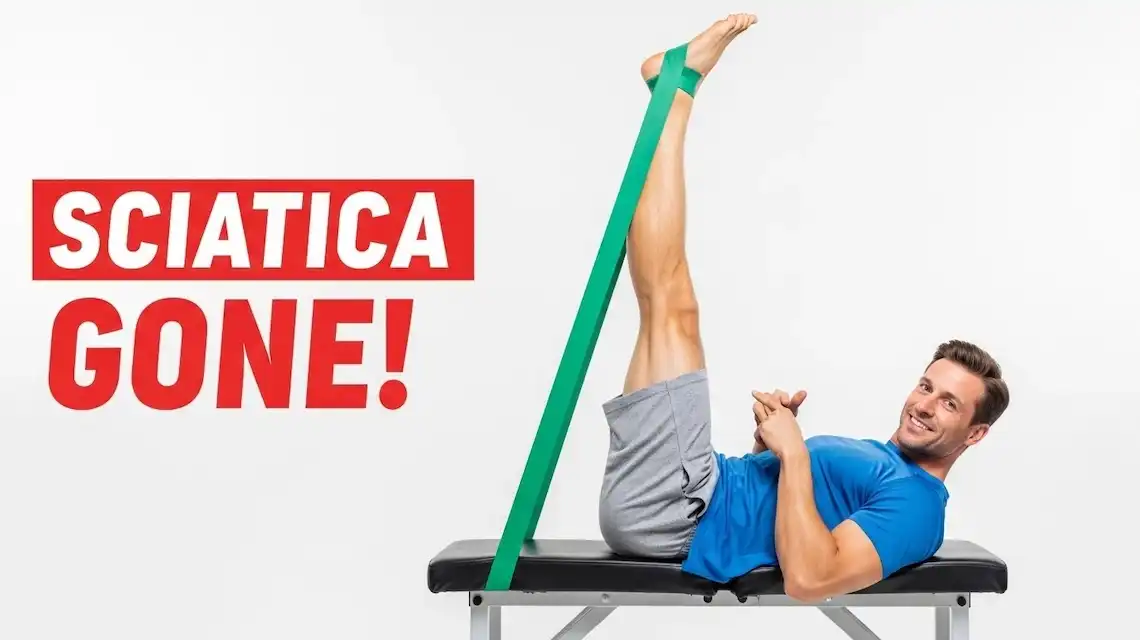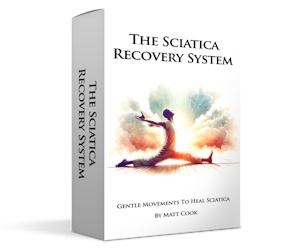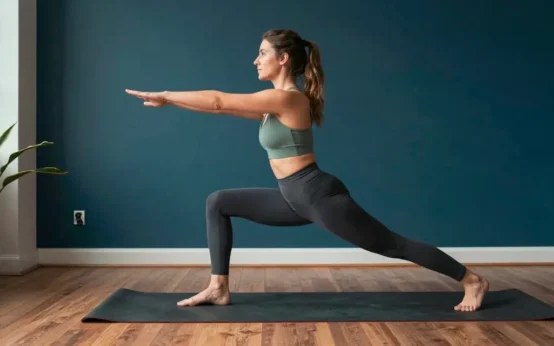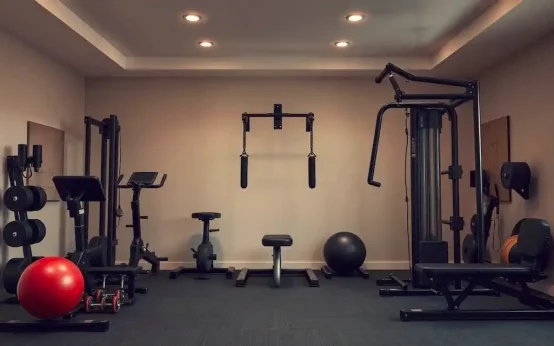Sciatica hurts in a very specific way. Pain, tingling, or numbness runs from the low back down the leg, sometimes all the way to the foot. If that sounds familiar, you are in the right place.
This guide gives you easy stretching exercises for sciatica that fit into 10 minutes. You can do them in a small space, even after a long day of sitting. Gentle stretching helps tight muscles relax, gives the nerve more room, and eases pressure along the path of the sciatic nerve.
This is not a cure for every cause, but it often reduces pain and stiffness. Start slow and listen to your body. Stop right away if sharp pain shoots down your leg, or if you feel new numbness or weakness. See a doctor now if you have loss of bladder or bowel control, saddle numbness, or sudden severe weakness. You will find a step-by-step routine, a quick warm up, and a simple weekly plan below.
What is sciatica and how can easy stretches help right now?
The sciatic nerve is the biggest nerve in your body. It starts in the lower spine, runs through the hips and butt, then down the back of each leg. When that nerve gets irritated or squeezed, you feel pain or odd sensations along its path.
Common triggers include long sitting, a disc bulge, tight piriformis, spinal stenosis, or muscle spasm. Even stress can ramp up muscle guarding and make the nerve feel more reactive.
Stretching helps in a few key ways:
- It lowers muscle guarding so you stop bracing all day.
- It improves blood flow around the spine and hips.
- It helps the nerve glide better between tissues, which can reduce zaps and pulling.
Gentle, regular movement also calms your nervous system. That drop in threat can lower pain. Most people feel some relief within days to weeks if they stay consistent. Move slowly and do not force any position. Comfort first, depth second.
Before you start: safety checks, quick warm up, and what pain is okay
A safe stretch feels like a 3 to 4 out of 10. Mild pulling, a bit of tightness, steady and manageable. Not a sharp, burning, or zapping pain. Move slow, do not bounce, and breathe throughout.
Warm up for 2 to 3 minutes with easy movement. Light marching, a short walk, or a warm shower or heat pack can help. Simple gear helps too. Keep a towel or strap, a chair, and a small pillow nearby.
Skip stretching and call a doctor if you had a recent major injury, have a fever, sudden severe pain in both legs, loss of bladder or bowel control, numbness in the saddle area, or fast-worsening weakness.
Check your symptoms: when to see a doctor first
Stop and seek medical care if any of the following are present:
- Loss of bladder or bowel control
- Numbness in the saddle area
- Sudden severe weakness in a leg
- Unplanned weight loss
- History of cancer
- Fever or night sweats
- Pain after a hard fall or trauma
If pain is mild to moderate and slowly improving, the routine below is likely safe.
Warm up in 2 minutes: get blood moving
Try this simple menu:
- 60 seconds of easy walking or marching in place
- 30 seconds of gentle pelvic tilts while standing or lying
- 30 seconds of heel raises while holding a chair
Keep your spine neutral and breathe slowly. You want to feel warm, not tired.
How to read pain so you do not overdo it
Safe signs: mild pulling, easing as you hold, and you feel better after you stand up. Unsafe signs: sharp or zapping pain, new or growing numbness or weakness. Use the talk test and aim for a 3 to 4 out of 10. If pain spikes, reduce the range or switch to an easier version.
Easy stretching exercises for sciatica: a gentle 10-minute routine
Follow these stretches in order. Breathe in through your nose, out through your mouth. Hold most stretches for 20 to 30 seconds and repeat 2 times on each side unless noted. Keep your movements smooth and unhurried. Use a towel or strap as needed. Chair or bed options are included.
Seated hamstring stretch with towel (eases pull on the sciatic nerve)
Why it helps: tight hamstrings can tug on the pelvis and irritate the nerve line.
Steps:
- Sit tall at the edge of a chair.
- Extend one leg with the heel on the floor, toes up.
- Loop a towel around the forefoot.
- Hinge gently at the hips with your chest up. Do not round your back.
- Feel a mild pull behind the thigh. Hold 20 to 30 seconds, 2 rounds each side. Breathe.
Easier option: lie on your back, loop the towel around your foot, and keep a soft bend in the knee. Stop if sharp calf pain builds.
Form cues:
- Think long spine and proud chest.
- Hinge from the hips, not the low back.
- Stop before pain and keep the stretch steady.
Figure-4 piriformis stretch on your back (opens the hip and reduces pressure)
Why it helps: the piriformis can tighten and press near the sciatic nerve. Loosening it can reduce hip and butt pain.
Steps:
- Lie on your back with both knees bent.
- Cross your right ankle over your left knee.
- Thread your hands behind the left thigh and pull gently toward your chest.
- Keep your head and shoulders relaxed.
- Hold 20 to 30 seconds, 2 rounds each side. Breathe.
Options:
- Press the right knee away lightly to feel the stretch in the hip.
- Chair version: sit tall, cross ankle over knee, hinge forward a little.
Form cues:
- Keep your tailbone heavy on the mat.
- If the stretch pinches, pull the knee slightly toward your opposite shoulder.
Single knee-to-chest hug (soothes low back and glutes)
Why it helps: calms the lower back and glute muscles that often guard with sciatica.
Steps:
- Lie on your back.
- Bring one knee toward your chest and hold the shin or behind the thigh.
- Keep the other leg bent with the foot on the floor for support.
- Hold 20 to 30 seconds, switch sides.
- Then try both knees to chest for 15 to 20 seconds.
Tips:
- Breathe slowly and relax your jaw and shoulders.
- If the hip pinches, pull the knee slightly to the outside.
Child’s pose with pillow support (gentle back and hip relief)
Why it helps: lengthens the low back and hips while quieting a tense nervous system.
Steps:
- Kneel on a mat, big toes together.
- Place your knees as wide as is comfortable.
- Sit back toward your heels and fold forward.
- Rest your arms forward or by your sides.
- Place a pillow under your chest or between your hips and calves if needed.
- Hold 30 to 45 seconds and breathe into your belly.
Chair option: sit with feet flat, hinge forward, and rest your forearms on your thighs.
Form cues:
- Keep the stretch gentle, not forced.
- If knees are sore, add extra pillow support.
Seated sciatic nerve glide (nerve flossing without strain)
Why it helps: lets the nerve slide better through tight tissues. This is a motion, not a long hold.
Steps:
- Sit tall on a chair.
- Extend one knee so the heel rests on the floor.
- As you gently look up, point your toes up.
- As you gently look toward your knee, point your toes down.
- Move slow with your breath, 10 smooth reps each side.
Key points:
- No sharp pain or long holds.
- Keep the motion small if symptoms rise.
- Think glide, not stretch.
Make it stick: daily plan, progress, and tips for long-term relief
Consistency beats intensity. Small daily effort adds up and helps calm a reactive sciatic nerve. Pair your routine with short walks and simple posture breaks so your body gets a steady message of safety and movement.
Your 10-minute daily plan for sciatica relief
Try this schedule:
- Warm up 2 minutes.
- Do the 5 stretches in order for about 8 minutes.
- Aim for 5 days a week.
If you sit a lot, add a 60-second mini break each hour: stand up, march in place, and do 5 nerve glide reps. Morning or evening both work. Pick the same time each day to build a habit.
When to progress and what to add next
After 1 to 2 weeks, start light core work 3 times a week. Pelvic tilts, bridges, or dead bug basics are great. Add a gentle hip flexor stretch if you sit long hours. If it feels good, increase stretch holds to 45 seconds. Add 10 to 20 minutes of easy walking most days. If pain increases for more than 24 hours, scale back.
Sample progressions:
- Pelvic tilts: 10 to 15 reps, slow and controlled.
- Bridges: 8 to 12 reps, pause for 2 seconds at the top.
- Dead bug basics: 5 to 8 reps per side, focus on slow breathing.
Simple tools that make stretching easier
- Towel or yoga strap: helpful for hamstring work without rounding your back.
- Firm pillow: supports child’s pose and reduces knee or hip pressure.
- Chair with a back: adds comfort and stability for seated options.
- Phone timer: keeps holds honest and consistent.
- Heat pack or warm shower: relaxes muscles before you start.
A quiet spot helps you focus on slow breathing and form. That alone can lower pain.
Mistakes to avoid so you get faster relief
- Do not bounce or force a deeper stretch.
- Do not hold your breath. Slow breaths help muscles relax.
- Do not round the low back in the hamstring stretch. Hinge at the hips.
- Do not push through sharp pain or numbness.
- Do not rely only on stretching. Add light daily walking and standing breaks.
Simple rule of thumb: better after movement means keep going. Worse for more than a day means adjust your dose.
A quick example day to keep you on track
Morning:
- Warm shower, then the 10-minute routine.
Daytime:
- Stand each hour for 60 seconds. March in place and do 5 nerve glides per leg.
Evening:
- 10 to 20 minute stroll, relaxed pace. If stiff after dinner, repeat the figure-4 and hamstring stretch for 20 seconds each.
Keep a simple log:
- What you did, pain before and after, and any notes. Patterns help you fine-tune your plan.
Key form cues at a glance
- Breathe steadily. In through the nose, out through the mouth.
- Aim for a 3 to 4 out of 10 stretch.
- Move slowly, no bouncing.
- Keep your spine long in hamstring work.
- Use pillows and straps to meet your body where it is today.
When stretching alone is not enough
Stretching helps many people, but not all. If your sciatica comes from a herniated disc or spinal stenosis, you may need a broader plan. That can include strength work, posture changes, weight bearing activity, and guided care. If you are unsure, a physical therapist can assess your pattern and adjust stretches to fit you.
Conclusion
Easy stretching exercises for sciatica can calm pain, loosen tight spots, and help you move better. Use the 10-minute routine most days, follow the safety tips, and track your progress. See a doctor if red flags show up or if pain keeps getting worse. Save this routine, set a daily reminder, and check in after two weeks to adjust the plan. Small steps, done often, build strong habits and a more comfortable body. Keep it gentle, stay consistent, and trust the power of simple movement.
Related post: What Exercise Can Help With Lower Back Pain
FAQ: Easy Stretching Exercises for Sciatica
What’s the goal of sciatica stretches?
Calm nerve irritation, ease muscle tension, and improve hip and back mobility. Stretches should reduce buttock or leg pain, not provoke it.
Which easy stretches help most?
Start with knee-to-chest, figure-4 piriformis stretch, hamstring stretch, child’s pose, and cat-cow. Add a gentle sciatic nerve glide if symptoms are stable.
How often should I stretch for sciatica?
Aim for 5 to 10 minutes, 1 to 2 times daily. Consistency matters more than long sessions.
How long should I hold each stretch?
Hold 15 to 30 seconds, repeat 2 to 4 times per side. Breathe slowly and stop before sharp pain.
What’s a safe way to do a figure-4 piriformis stretch?
Lie on your back. Cross your ankle over the other knee. Pull the uncrossed thigh toward your chest. You should feel a deep hip stretch, not knee pain.
How do I stretch tight hamstrings without flaring symptoms?
Use a strap or towel behind your foot while lying down. Keep a slight knee bend, pull until a gentle stretch, and hold. Avoid bouncing.
What’s a sciatic nerve glide, and when should I use it?
It moves the nerve gently to reduce sensitivity. While seated, extend one knee and flex the ankle as you look up, then bend the knee and point the toe as you look down. Move slowly for 10 to 15 reps. Skip it if it increases leg pain.
Should I warm up first?
Yes. Take a short walk, do gentle marching, or try cat-cow for one minute. Warm tissues tolerate stretch better.
What if stretching increases my leg pain?
Stop and scale back. Shorten holds, reduce range, or choose a different stretch. Persistent or worsening pain needs a medical check.
Can I stretch during a pain flare?
Use very gentle positions, like child’s pose or supported figure-4. Keep holds brief. Focus on breathing and comfort, not depth.
Which stretches help if I sit all day?
Do seated figure-4, seated hamstring stretch, standing calf stretch, and hip flexor lunge. Take short movement breaks every 30 to 60 minutes.
Are there stretches to avoid?
Avoid deep forward folds with locked knees, aggressive toe touches, or twisting with force. Pain that shoots or tingles is a stop sign.
Is stretching alone enough?
Often you need both stretching and strengthening. Add core work, glute bridges, and hip abduction once pain settles.
How long before I feel better?
Some feel relief right away, others after 2 to 4 weeks of steady work. If you see no change in two weeks, talk with a clinician.
Can I stretch in the morning?
Yes, but move slower at first. Bodies feel stiff on waking. Start with cat-cow and knee-to-chest, then add others.
Any tips for safer stretching?
Move within comfort, breathe, and avoid holding your breath. Keep your spine neutral when possible. Use pillows, a strap, or a wall for support.
Should pregnant people modify sciatica stretches?
Yes. Avoid deep supine positions later in pregnancy. Use side-lying or seated versions and extra pillows. Check with your provider if unsure.
When should I see a doctor or physical therapist?
Seek care for severe pain, weakness, trouble walking, bowel or bladder changes, or numbness that does not ease. Early help can speed recovery.
Can I keep walking or exercising?
Yes, if symptoms stay stable. Gentle walking, swimming, or cycling pairs well with stretching. Stop if pain shoots down the leg.




 Beginner Cardio Workout at Home
Beginner Cardio Workout at Home  10 Stretching Exercises to Increase Height
10 Stretching Exercises to Increase Height  Menopause Workout: A Simple, Strong Plan
Menopause Workout: A Simple, Strong Plan  Best Home Gym Workout Equipment
Best Home Gym Workout Equipment  Exercise Tips Help You Look Great for Your Age
Exercise Tips Help You Look Great for Your Age  How to Stay Active With Back Pain
How to Stay Active With Back Pain